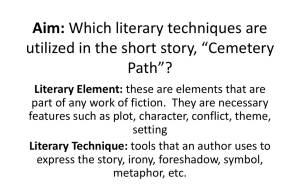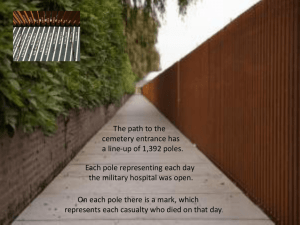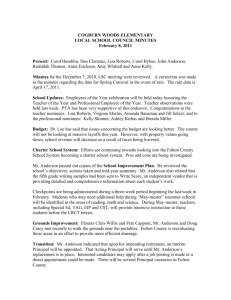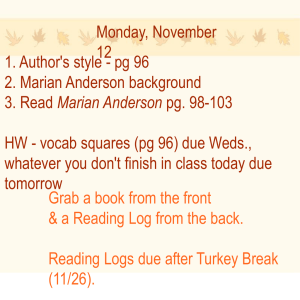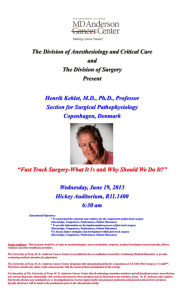Resources - Historic Cemeteries Conservation Trust of New
advertisement
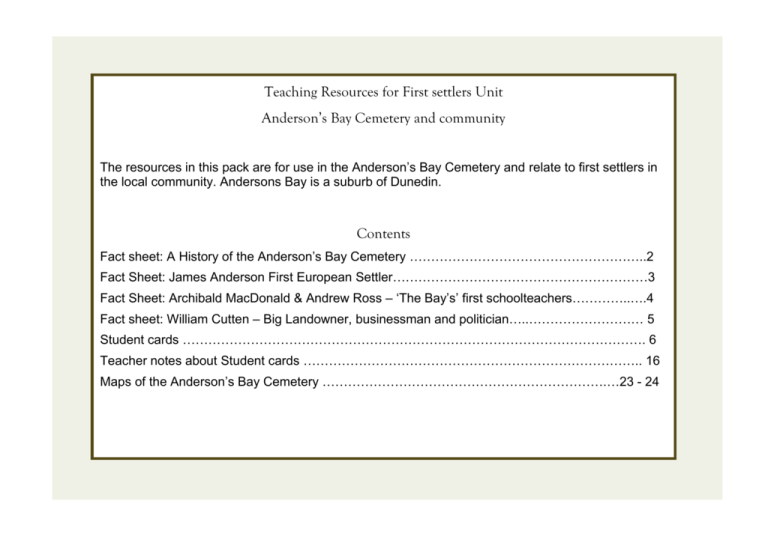
Teaching Resources for First settlers Unit Anderson’s Bay Cemetery and community The resources in this pack are for use in the Anderson’s Bay Cemetery and relate to first settlers in the local community. Andersons Bay is a suburb of Dunedin. Contents Fact sheet: A History of the Anderson’s Bay Cemetery ………………………………………………..2 Fact Sheet: James Anderson First European Settler……………………………………………………3 Fact Sheet: Archibald MacDonald & Andrew Ross – ‘The Bay’s’ first schoolteachers…………..….4 Fact sheet: William Cutten – Big Landowner, businessman and politician…..……………………… 5 Student cards ………………………………………………………………………………………………. 6 Teacher notes about Student cards …………………………………………………………………….. 16 Maps of the Anderson’s Bay Cemetery ………………………………………………………….…23 - 24 First Settlers Study – Anderson’s Bay Cemetery The Anderson’s Bay Cemetery Fact Sheet – A brief history of the Anderson’s Bay Cemetery The cemetery was first surveyed by Charles Kettle. The first recorded burial was on the 1st May 1867 though it is likely there were earlier unrecorded burials as Henry Duckworth (1923 p 31) mentions the burial of James Kelly aged 10 months on 21st November 1857. He was buried amongst the flax bushes with a post and rail grave being put around the grave to keep off stray cattle. In 1862 three acres was fenced and the ground cleared and burial sections laid out ready for sale. In 1890 12 additional acres were secured alongside and then in 1894 the remainder of the block was applied for making 60 acres altogether. The first Sexton was Mr Campbell. He was succeeded by Mr Daniel Weir. A management committee oversaw the cemetery. A plain hearse and set of harness were obtained for subscriptions of £1.00 each. Non-subscribers paid a small sum for the use of them and needed to supply their own horse and driver. (Duckworth 1923 p 31) In 1903 the managers called a public meeting with a proposal to hand over the cemetery to the Dunedin Corporation which had agreed to bring the electric train up to Samuels Store near the junction of Tomahawk and Highcliff Roads. The trams were never to come to the cemetery gates. Cemetery became almost the only operating cemetery from about the time of the First World War. A crematorium was built, with the first cremation occurring in 1927. All the plots in the burial section were sold by April 1978, although some sections were being sold for returned servicemen beyond that date. Ashes beams are still being created. From Duckworth H. (1923). Anderson’s Bay in the Early Days. Dunedin. Otago Heritage Books 1982. Also previously published by Coulls Somerville Wilkie 1923 from the type used in the Otago Daily Times and titled Early Otago: History of Anderson’s Bay from 1844 to December 1921 and Tomahawk from 1857 to March 1923 First Settlers Study – Early Identities not buried in the Anderson’s Bay Cemetery Fact Sheet – James Anderson first European Settler Anderson’s Bay was named after the first European settlers to arrive there. They were James Anderson, his son John and John’s wife Isabella. They arrived from Nelson on the 30th December 1844 having heard that a Scottish settlement was to be established in the area. The settlement plans for Otago were postponed however the trio built a ‘whare’ near the inlet close to Ross’ corner – the junction of Somerville and Silverton Streets. They lived there for two years and were able to ‘live well enough’ supplementing their flour supply with fish, pigs, and birds as well as trading with Otakou and Waikouaiti Maori. John Anderson joined Charles Kettle’s party in 1846 to assist with the first survey The Anderson’s then left the inlet and settled in Pelichet Bay on the other side of the harbour. John and Isabella were to have their first son born there. He was the first European child born in Dunedin. John Anderson died in 1848, and was buried in the York Pace Cemetery, Dunedin’s first cemetery. In 1880 the graves at the cemetery were removed and the obelisk you see today was erected. James Anderson’s name is one of those listed on the plaques. of Dunedin. (Duckworth p.10) John and Isabella took up land in South Otago. Their descendents did return to Anderson’s Bay and there is a memorial headstone that commemorates the Anderson’s in the Anderson’s Bay Cemetery. First Settlers Study – Early Identities not buried in the Anderson’s Bay Cemetery Fact Sheet – Archibald MacDonald & Andrew Russell - “The Bay’s first school-teachers The settlers in Anderson’s Bay initially paid for the education required for their children when no immediate assistance was forthcoming from the education committee. Archibald MacDonald had been a schoolmaster in Scotland. He came to Dunedin as a passenger on the Philip Laing. He started the primary school in Mr Duff’s house located at Ross’ Corner in 1851. He was the first private teacher in Anderson’s Bay. In time, a second school was kept in Mr Law’s House, by Mr William Somerville. (Duckworth, 1923). The tombstone pictured here commemorates Mr Archibald MacDonald and his family and is located in Dunedin’s Southern Cemetery in Block 2P Plot 44. Map shows location of the MacDonald family grave in Dunedin’s Southern Cemetery. It is in the Anglican section of the cemetery Map portion of Dunedins Southern Cemetery sourced from Dunedin City Council: Location of Dunedin’s cemeteries http://www.dunedin.govt.nz/facilities/cemeteries/location-pdfs Andrew Russell was the first Education Board school teacher to the district (appointed in 1857). According to Duckworth (p.16 ) he was a very strict teacher and did not “spare the rod” on his pupils. Andrew Russell moved on and taught elsewhere in Dunedin and even in the Chatham Islands. He died in Melbourne. His wife Elizabeth is buried in the Anderson’s Bay Cemetery and he is mentioned on the memorial located in Block 6 Plot 18. (Duckworth. p16) First Settlers Study – Early Identities not buried in the Anderson’s Bay Cemetery Fact Sheet – William Cutten: Landowner, businessman and politician William Cutten was 26 when he arrived in Dunedin on the John Wickliffe. He had accompanied Captain William Cargill as a cabin passenger, becoming Cargill’s son in law when he married Cargill’s eldest daughter, Christina in 1850. He was an early Dunedin businessman and entrepreneur. He first set up in Dunedin as an auctioneer. He was a talented writer. He was presented with the property and running of the Otago Witness newspaper in October 1851. He set up the printing press in his auction rooms on the foreshore. Then he and Julius Vogel launched the first daily paper in New Zealand, the Otago Daily Times, on 15 November 1861. Map shows location of the Cutten family grave in Dunedin’s Northern Cemetery. Also in 1861 he bought a property from James Adam that included a farm that extended almost to Lawyers Head and built a large house called Belmont on the area that was called Goat Hill (now called Sunshine). He became involved in local and national politics and held several important offices in his political career. He was also a member of the University Council. Although a settler in the Anderson’s Bay area he is buried in Dunedin’s Northern Cemetery. His memorial can be found in Block 3 Plot 7. Map portion of Dunedin’s Southern Cemetery sourced from Dunedin City Council: Location of Dunedin’s cemeteries http://www.dunedin.govt.nz/facilities/cemeteries/location-pdfs Student cards The following pages are the templates for the student cards. Print onto light card, cut out, and fold along each card along the dotted line. Put in a box and take to the cemetery. Student groups “dig” for a grave, which will be their ’first settler’ family to investigate. There are 18 families available for investigation. There are 12 families from the first ships and 6 families of later identities. Choose the number of cards you think your class can manage. At the Anderson’s Bay Cemetery – First settlers from first ships Student work cards – Cut out fold in half and give one to each group Block 1 Plot 16 (Duckworth) Block 1 Plot 34 (Begg) Fold 2 1 Fold At the Anderson’s Bay Cemetery – First settlers from first ships Student work cards – Cut out fold in half and give one to each group Block 11 Plot 15 (Grainger) Block 12 Plot 17 (Brown) Fold 3 4 Fold At the Anderson’s Bay Cemetery – First settlers from first ships Student work cards – Cut out fold in half and give one to each group Block 1 Plot 23 (Sanderson) Block 14 Plot 22 (Robertson) Fold 6 5 Fold At the Anderson’s Bay Cemetery – First settlers from first ships Student work cards – Cut out fold in half and give one to each group Block 1 Plot 27 (Somerville) Block 7 Plot 13 (Somerville) Fold 8 7 Fold At the Anderson’s Bay Cemetery – First settlers from first ships Student work cards – Cut out fold in half and give one to each group Block 1 Plot 40 (Weir) Block 1 Plot 43 (Weir) Fold 10 9 Fold At the Anderson’s Bay Cemetery – First settlers from first ships Student work cards – Cut out fold in half and give one to each group Block 105 Plot 63 (Anderson) Block 4 Plot 31 (Patrick) Fold 12 11 Fold At the Anderson’s Bay Cemetery – Later settlers to Anderson’s Bay Student work cards – Cut out fold in half and give one to each group Block 4 Plot 37 & 39 (Every) Block 7 Plot 22 (Jeffery) Fold 14 13 Fold At the Anderson’s Bay Cemetery – Later Settlers to Anderson’s Bay Student work cards – Cut out fold in half and give one to each group Block 11 Plot 26 (Ross) Block 11 Plot 53 (Smaill) Fold 16 15 Fold At the Anderson’s Bay Cemetery – Later Settlers to Anderson’s Bay Student work cards – Cut out fold in half and give one to each group Block 11 Plot 26 (Russell) Block 11 Plot 53 (Samuel) Fold 18 17 Fold Brief Notes for teachers on the Headstones The following pages provide some brief notes for teachers about the cemetery headstones that feature on the cards issued to students. You may wish to use a lesser number of headstones than are provided here. There are 12 families who arrived on the first ships that left Britain before the end of 1850. There are an additional 6 families who arrived in the district a little later who in various was left their mark on the community. Two of these, Andrew L Russell and James Jeffrey were teachers and headmasters of Anderson’s Bay School. Andrew L Russell was the first Education Board appointed teacher in 1847. At the Anderson’s Bay Cemetery – First settlers from first ships (12 families) Brief notes for teachers about cemetery headstones for study Block 1 Plot 16 1 2 1 Plot 34 Block This tombstone commemorates Robert and Margaret Duckworth and their son Henry. This tombstone commemorates Adam and Isabella Begg and their son Charles. Robert and Margaret Duckworth emigrated from Scotland and arrived with four children on the Mary in April 1849. Henry Duckworth was born in Dunedin but spent his life in Anderson’s Bay. Adam and Isabella Begg emigrated from Scotland and arrived with four children on the Blundell in September 1848. 4 3 Block 11 Plot 15 This tombstone commemorates Thomas and Margaret Grainger who emigrated from Scotland. They in arrived in Dunedin on the Larkins in September 1849. There is also James Elder Brown who settled in Anderson’s Bay. He arrived on the Ajax in 1849 and is mentioned by Henry Duckworth. He cannot be located in the Anderson’s Bay Cemetery with any certainty. Block 11 Plot 15 This nameplate commemorates James and Hannah Brown who emigrated from Scotland. They in arrived in Dunedin with one child on the Philip Laing in April 1848. The headstone is a surname only. The students who investigate this family will need to use the Cemeteries database for information. At the Anderson’s Bay Cemetery – First settlers from first ships (12 families) Brief notes for teachers about cemetery headstones for study 5 Block 14 Plot 22 6 This tombstone commemorates Thomas Robertson. He in arrived in Dunedin with his second wife Elizabeth and six children (5 to his first wife) on the Philip Laing in April 1848. Block 1 Plot 22 and 23 This tombstone commemorates William and Helen Sanderson. William and Helen Sanderson emigrated from Scotland on the Cornwall arriving in September 1849. Elizabeth Robertson died in April 1865. Thomas Robertson married Margaret Napier in October 1865. Block 17Plot 27 This tombstone commemorates John and Janet Somerville who emigrated from Scotland. They in arrived in Port Chalmers on the Blundell in September 1848 with their nine children. 8 Block 7 Plot 13 This tombstone commemorates William Somerville who emigrated from Scotland with his parents Janet and John. He left Scotland when he was 15 years of age. At the Anderson’s Bay Cemetery – First settlers from first ships (12 families) Brief notes for teachers about cemetery headstones for study 9 Block 1 Plot 40 This tombstone commemorates Daniel and Catherine Weir who emigrated from Scotland with 3 children. They arrived on the Blundell in September 1848. 11 10 Block 1 Plot 43 This tombstone commemorates Cochrane and Alison Weir. Cochrane Weir emigrated from Scotland on the Blundell with his parents Daniel and Catherine arriving in September 1849. He was aged six when he left Scotland. Block 105 Plot 63 This tombstone commemorates John and Isabella Anderson, first settlers at Anderson’s Bay. John and Isabella left the Andersons Bay area and are buried elsewhere. This stone has been erected by their children who are buried here and who have included their parents’ names on this memorial. 12 Block 4 Plot 31 This stone commemorates James and Isabella Patrick who emigrated from Scotland aboard the Philip Laing. James and Isabella were the first settlers at Tomahawk. At the Anderson’s Bay Cemetery – Later settlers to Anderson’s Bay (6 families) Brief notes for teachers about cemetery headstones for study 13 Block 4 Plot 39 Block 7 14 This tombstone commemorates Simon Frederick Every and his wife Mary who arrived in New Zealand about 1858. Simon originated from England, and was the fourth son of an English Baronet. 15 Block 11 Plot 26 This tombstone commemorates Hugh Ross and his wife Margaret and family. He arrived in Dunedin about 1863 and was a long term resident of Anderson’s Bay. Plot 22 This tombstone commemorates James Jeffery and his wife Annie. James Jeffery was born in Victoria Australia and was a long-term principal of the Andersons Bay School. 16 Block 11 Plot 53 This tombstone commemorates Charles Smaill and his wife Isabella as well as a daughter and a son. The Smaill family settled at Tomahawk soon after the Patrick Family settled there. At the Anderson’s Bay Cemetery – Later settlers to Anderson’s Bay (6 families) Brief notes for teachers about cemetery headstones for study Block 6 Plot 18 17 This tombstone commemorates Andrew L Russell and his wife Elizabeth who arrived in New Zealand about 1857 from Scotland. Andrew Russell was the first education board appointed schoolteacher to the school in 1857. Note this Andrew Russell was the second schoolteacher by this name to come to Dunedin in the early days. The first Andrew Russell arrived on the Lady Nugent and opened an academy for boys in North East Valley. 18 Block 6 Plot 26 This tombstone commemorates James and Mary Samuel who arrived in Dunedin aboard the Pladda on the 18th August 1860. They were also long tern residents of the Anderson’s Bay community. Cemetery Maps The following pages provide maps of the Andersons Bay cemetery. The first is a large overall map of the cemetery. The second is a map detail showing the historic area of the cemetery. The only memorial that students will need to visit outside of the compact historic area located by the bus shelter on Tomahawk Road is the Anderson Family Memorial commemorating the Bay’s first settlers, John and Isabella Anderson. Both maps show Block numbers only. Students will have to look carefully for the headstones by shape and by inscription. Anderson’s Bay Cemetery Tomahawk Road Dunedin. Map of Dunedin’s Andersons Bay Cemetery sourced from : http://www.dunedin.govt.nz/__data/assets/pdf_file/0020/25454/cemplot_andybay1photo.pdf Detailed Map of Historic Area Anderson’s Bay Cemetery Map showing the location of the blocks in the cemetery 1 1 N Bus shelter 20 Location of all headstones except for the Anderson plot in Block 105 Map of Dunedin’s Andersons Bay Cemetery sourced from : http://www.dunedin.govt.nz/__data/assets/pdf_file/0020/25454/cemplot_andybay1photo.pdf Block location shape and number. Blocks are labelled on the ends of blocks Sealed roads
